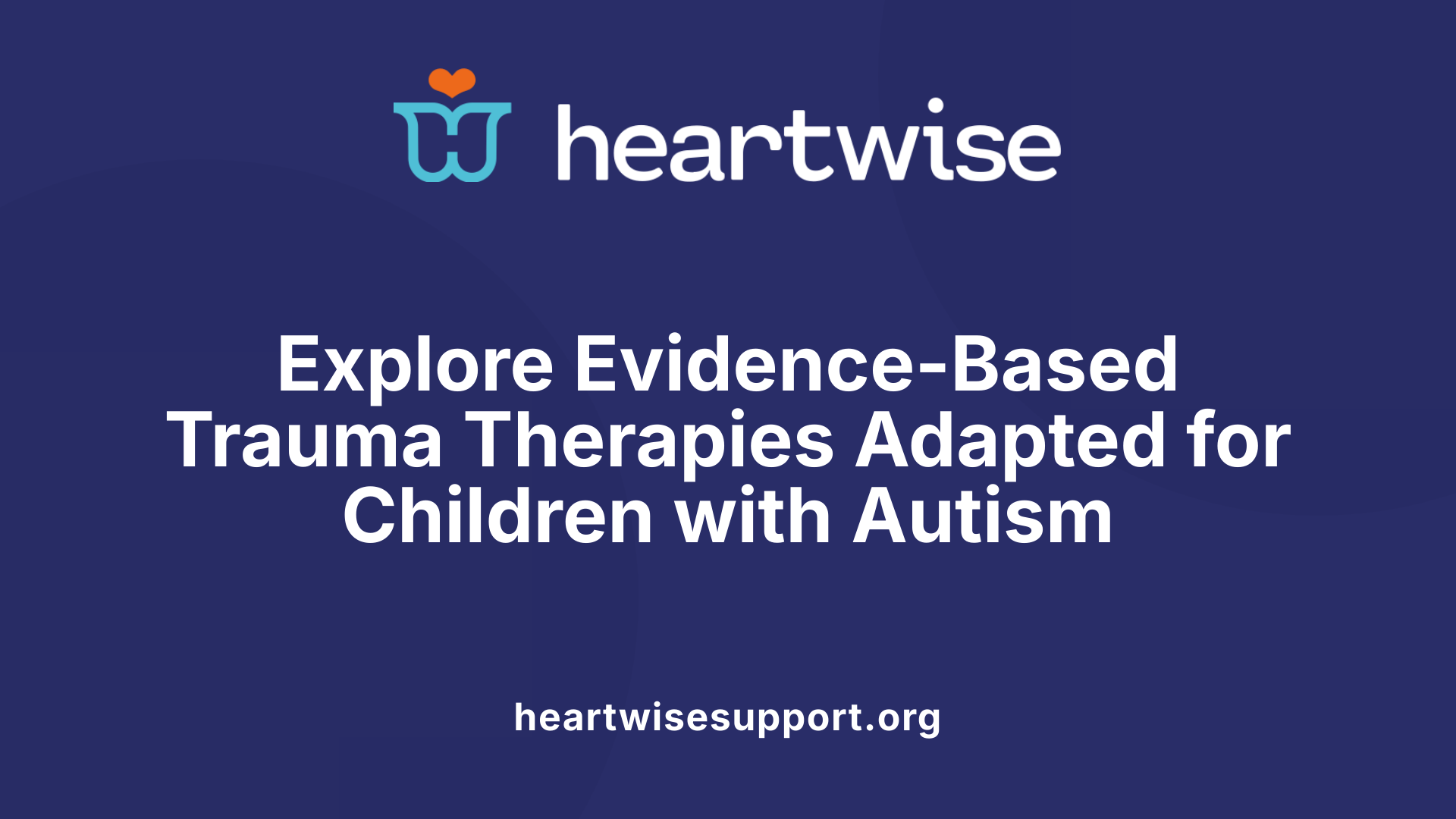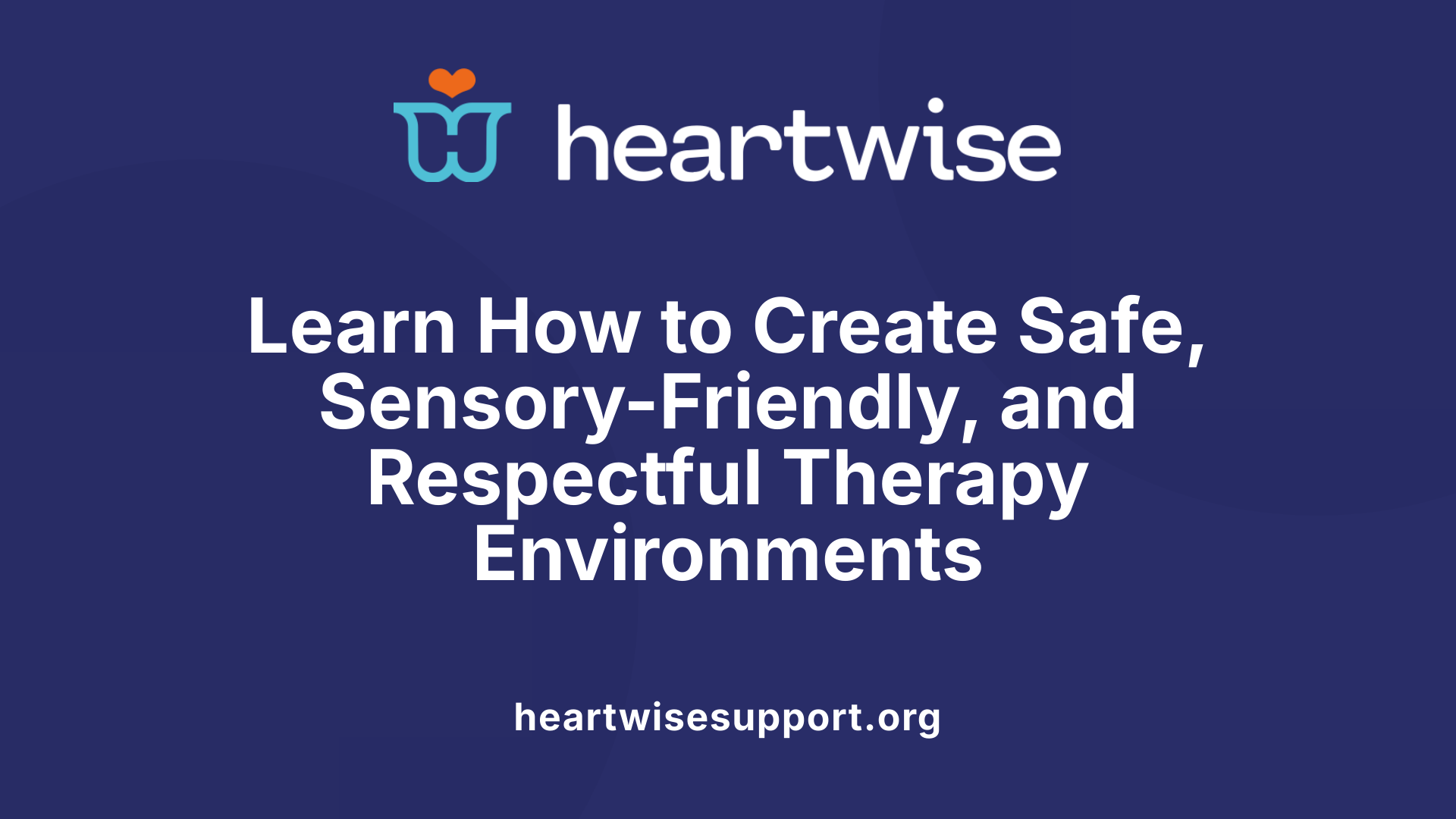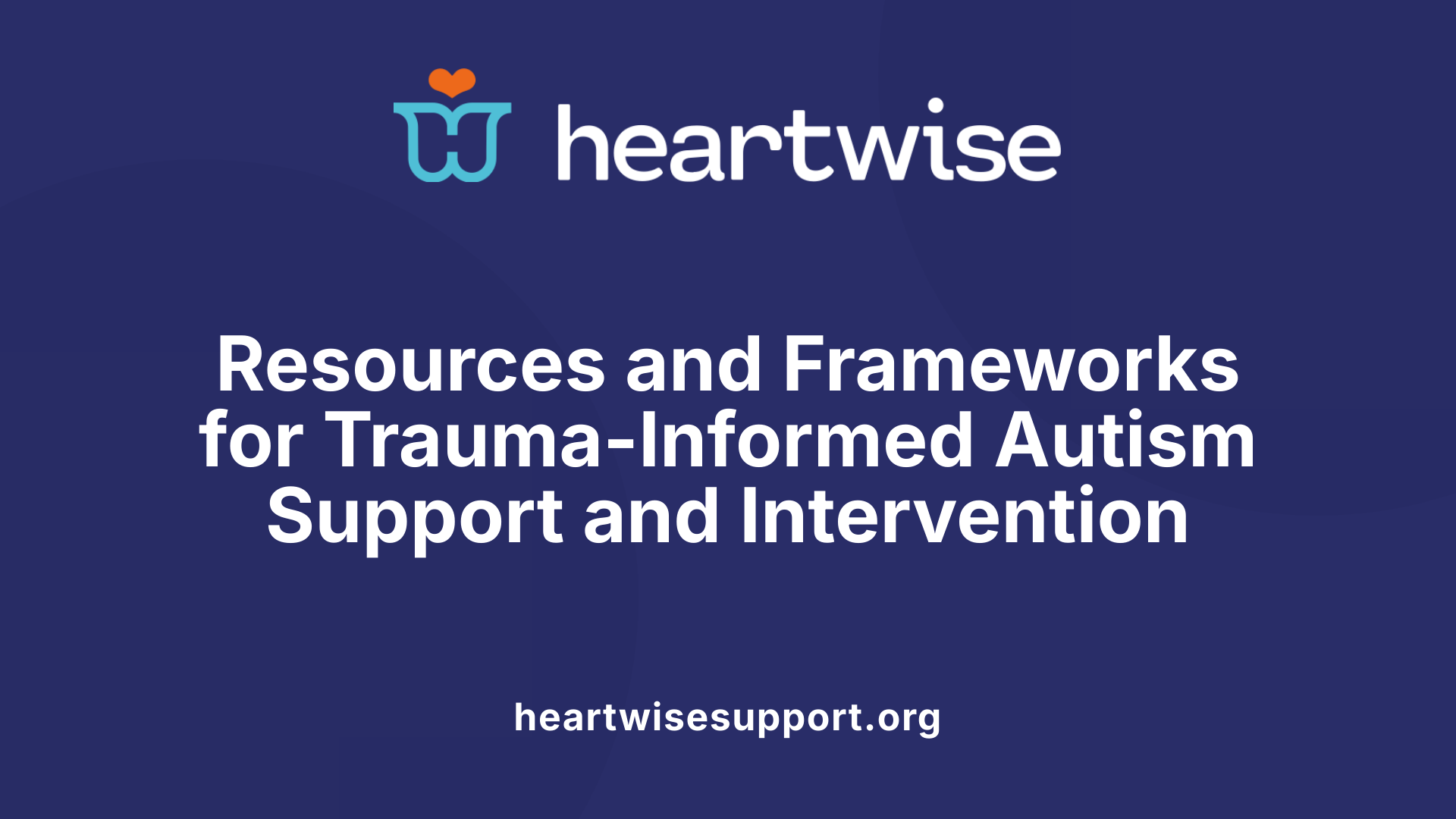Understanding and Supporting Trauma in Autism Spectrum Disorder
Children with autism spectrum disorder (ASD) are at a significantly increased risk of experiencing trauma due to their unique sensory, social, and communication challenges. These adverse experiences include bullying, social exclusion, abuse, and sensory overload, which can profoundly impact their mental health. Recognizing the high prevalence and distinct ways trauma manifests in children with autism is essential for providing effective, tailored interventions. This article explores various therapeutic options, adaptations for safe and effective practice, and resources available to assist clinicians and caregivers in supporting trauma recovery among this vulnerable population.
Types of Trauma-Focused Therapies for Children with Autism

What are the trauma-focused therapy options for children with autism?
Trauma in children with autism spectrum disorder (ASD) can manifest differently due to their unique cognitive, sensory, and communication challenges. To address these needs, various evidence-based therapies have been adapted for autistic children.
Trauma-Focused Cognitive Behavioral Therapy (TF-CBT) stands out as the most supported treatment. It helps children process traumatic memories, develop coping skills, and reduce trauma symptoms. TF-CBT can be modified with visual aids, caregiver involvement, and sensory-friendly techniques to suit individual needs.
In addition to TF-CBT, other therapeutic options include EMDR (Eye Movement Desensitization and Reprocessing), which uses guided eye movements or sensory stimulation to help reprocess traumatic memories. Somatic therapies focus on bodily sensations, promoting trauma release through movement or tactile interventions. Internal Family Systems Therapy (IFS) involves exploring different inner parts of the child’s psyche, fostering self-compassion and integration.
These approaches provide a spectrum of options tailored to the sensory sensitivities and communication styles of children with ASD. Successful treatment often combines these therapies with sensory accommodations and caregiver support to foster recovery and resilience.
| Therapy Type | Description | Adaptations for ASD |
|---|---|---|
| TF-CBT | Proven to reduce trauma symptoms | Visual supports, caregiver involvement, sensory adjustments |
| EMDR | Reprocessing traumatic memories through guided sensory stimuli | Use of tactile devices, simplified sessions |
| Somatic Therapies | Focus on body sensations and movement | Gentle movements, sensory-friendly environments |
| Internal Family Systems | Parts work approach to self-integration | Clear, concrete language, paced sessions |
Overall, these therapies offer promising avenues for children with ASD experiencing trauma, especially when tailored to their individual sensory and communication needs.
Adapting Therapy to Avoid Re-Traumatization in Autistic Individuals

How can therapy be adapted to avoid traumatizing autistic individuals?
When providing mental health support to autistic individuals, tailoring therapeutic approaches to their unique needs is essential to prevent re-traumatization.
Creating sensory-friendly spaces is a foundational step. These environments reduce overwhelming stimuli, such as bright lights or loud sounds, which can trigger anxiety or meltdowns. Incorporating calming visuals, soft textures, and quiet zones can make the space more welcoming.
Validating feelings and experiences plays a vital role in building trust. Autistic individuals often communicate differently and may have difficulty expressing emotions verbally. Therapists should actively listen, acknowledge their perspectives, and avoid dismissing or invalidating their reactions.
Using strengths-based approaches focuses on empowering the individual. Highlighting their abilities and interests helps foster confidence and resilience. This encourages cooperative participation and can make therapy more engaging.
Tailoring interventions involves customizing techniques to suit each person’s cognitive, communication, and sensory profiles. Rather than relying on one-size-fits-all methods, therapists should assess and incorporate preferred communication styles, such as visual supports, written cues, or alternative speech methods.
Ongoing autism awareness training is crucial for clinicians. Continuous education about autism traits, sensory sensitivities, and best practices ensures therapists remain knowledgeable about potential sources of distress. This training supports the development of flexible, sensitive, and effective therapeutic strategies.
By emphasizing a respectful, individualized, and informed approach, therapists can create a safe space that reduces the risk of re-traumatization, promotes healing, and builds a foundation for positive mental health outcomes in autistic individuals.
Trauma and Its Prevalence in Children with Autism
Children with autism spectrum disorder (ASD) are at an increased risk of encountering traumatic experiences such as physical, sexual, and emotional abuse, bullying, social exclusion, and sensory overload. Due to difficulties in social communication and sensory sensitivities, autistic children often find themselves more vulnerable to victimization and social rejection compared to their neurotypical peers.
Trauma sources in this population extend beyond social factors, including environmental stressors like sudden changes in routines, loud noises, or overwhelming sensory stimuli, which can imitate traumatic responses. These stressors frequently lead to behavioral and emotional disturbances, including anxiety, aggression, and self-injury.
Research highlights that autistic individuals experience PTSD symptoms at notably higher rates, with estimates suggesting that between 32-45% may have probable PTSD. Diagnosing PTSD in children with autism presents challenges due to overlapping symptoms, such as regression, hyperarousal, and social withdrawal, complicating recognition and treatment.
Prevalence studies reveal that trauma-related disorders are common among autistic children, especially those exposed to multiple stressors or adverse childhood experiences (ACEs). Factors like victimization, family violence, and neglect are linked to increased trauma exposure. The COVID-19 pandemic further heightened these risks, often resulting in increased maltreatment and victimization.
The impact of trauma on neurological development in children with ASD can include alterations in brain structures like the hippocampus and amygdala, which are involved in stress regulation and emotional processing. Such changes may exacerbate existing autism-related challenges, leading to difficulties in emotional regulation, learning, and social interactions.
Overall, understanding the high prevalence and complex presentation of trauma in children with autism requires specialized assessment tools and adapted therapeutic interventions to effectively identify and address trauma-related symptoms, ensuring better long-term outcomes for this vulnerable group.
For further information on trauma prevalence in children with autism, searches using terms like "Trauma prevalence in children with autism" can provide additional resources and recent research findings.
Supporting Caregivers to Aid Trauma Recovery

How can caregivers support autistic children who have experienced trauma?
Supporting children with autism spectrum disorder (ASD) who have endured trauma involves a combination of creating a stable environment and employing communication strategies that align with their unique needs. Caregivers should focus on establishing predictable routines and a safe space, as consistency helps reduce uncertainty and anxiety, which are common stressors for autistic children.
Utilizing visual supports such as social stories, visual schedules, and concrete language is essential. These tools help children understand their experiences, upcoming changes, and safety rules, fostering feelings of control and understanding. For example, clear, simple explanations of new routines or sensory experiences can diminish confusion and fear.
Grounding exercises are also effective. Techniques like deep breathing, focusing on sensory input, or engaging with calming music help children stay present and manage overwhelming feelings. Sensory regulation methods, such as using fidget toys or weighted blankets, can further support emotional stability.
It’s important to monitor media exposure, especially if children encounter distressing content that could intensify their trauma symptoms. Providing reassurance through consistent, calm communication helps children feel secure. Offering opportunities for expressive activities like drawing, play therapy, or other alternative communication methods allows children to process and share their feelings.
Building a trusting and emotionally warm relationship is crucial. Children who feel safe and supported are more likely to engage openly with caregivers and feel secure enough to recover from trauma.
When necessary, seeking professional assistance from therapists experienced in trauma and autism can provide additional strategies tailored to the child's specific circumstances. Caregivers should also attend to their own mental health, practicing self-care and stress management, which in turn supports their ability to help their children.
In summary, practical steps such as routine stabilization, visual supports, grounding exercises, media monitoring, and professional support create a comprehensive approach to aid recovery and foster resilience in traumatized children with ASD.
Implementing Trauma-Informed Practices in Autism Care

What resources are available for trauma-informed practices in working with children with autism?
Practitioners and caregivers aiming to adopt trauma-informed care for children with autism have access to a variety of authoritative resources. One of the most comprehensive is the Substance Abuse and Mental Health Services Administration (SAMHSA)’s 'Concept of Trauma and Guidance for a Trauma-Informed Approach.' This framework provides fundamental principles that are applicable across different populations, including children with ASD, emphasizing safety, trustworthiness, peer support, collaboration, empowerment, and cultural competence.
In addition, the 'Trauma and Autism Spectrum Disorder: A Reference Guide' from the University of Washington offers targeted information, strategies, and considerations specifically tailored to children with autism and their unique trauma responses. Organizations such as AIDE Canada and the Hogg Foundation also provide practical toolkits, factsheets, and training materials designed to enhance understanding and response strategies for trauma among neurodiverse populations.
Digital platforms support ongoing professional development through webinars, online training modules, and virtual workshops that focus on trauma’s complex impact on individuals with ASD. These online resources include guidance on assessment procedures, emotion regulation techniques, sensory supports, and trauma-sensitive communication tailored to therapeutic settings like ABA. Additionally, publications such as the Pennsylvania Department of Human Services' Positive Approaches Journal deliver research findings, environmental adaptation strategies, and evidence-based interventions aimed at trauma-affected children.
By utilizing these resources, clinicians, educators, and caregivers can implement trauma-informed, compassionate practices that respect the individual needs of children with autism. The collective knowledge from these materials aids in creating safe, supportive environments that foster resilience and recovery.
Emerging Research and Opportunities in Trauma Treatment for Autism
What is known about trauma and its prevalence in children with autism?
Research shows that children with autism are more vulnerable to experiencing traumatic events such as abuse, bullying, social rejection, and sensory challenges than their neurotypical peers. These children often encounter heightened risks during stressful situations like the COVID-19 pandemic, where reports indicate increased maltreatment and victimization rates. Trauma-related conditions, especially PTSD, are often underdiagnosed due to difficulties in communication and symptom overlap with autism traits.
Studies reveal that approximately 32-45% of autistic individuals may show probable PTSD symptoms, a significantly higher prevalence than the general population’s 4-4.5%. Autistic traits like sensory sensitivities, inflexible thinking, and challenges in emotional regulation tend to increase both the exposure to trauma and the risk of developing PTSD.
Addressing trauma in autistic children necessitates specialized assessment tools that are adapted to their unique presentations, including visual aids and caregiver reports. Early identification and tailored interventions are crucial to help mitigate long-term psychological impacts and improve overall well-being.
Current studies on adapted TF-CBT and current methodologies
Research efforts are increasingly focusing on modifying Trauma-Focused Cognitive Behavioral Therapy (TF-CBT) for children with autism. Recent studies test the efficacy of visually supported tools, flexibility in therapy structure, and incorporating individual interests to enhance engagement.
For example, some programs introduce visual schedules, written reward systems, and involve caregivers more actively to ensure comprehension and emotional safety. These adaptations aim to maintain the core components of TF-CBT—psychoeducation, coping skills, trauma narrative, and safety planning—while making the process accessible for autistic children.
Preliminary findings suggest that adapted TF-CBT delivered via teletherapy can be as effective as traditional in-person sessions, broadening access for children in remote or underserved areas.
Quantitative and qualitative research on trauma in ASD
Both quantitative data, such as prevalence rates and symptom severity measures, and qualitative insights, including personal accounts and caregiver reports, contribute to understanding trauma in ASD. Instruments like the Child and Adolescent Trauma Screen (CATS) are being refined to better capture trauma experiences specific to autism, considering sensory overload and social trauma.
Qualitative research emphasizes the importance of understanding individual experiences, highlighting that trauma manifests differently depending on cognitive and communication abilities. These insights inform the development of more nuanced assessments and personalized interventions.
Long-term treatment programs and their outcomes
Emerging longitudinal studies analyze how trauma-focused treatments influence the mental health trajectories of children with autism. Early evidence indicates that consistent therapy that incorporates sensory and behavioral modifications can reduce trauma symptoms and improve resilience.
Programs that integrate psychoeducation, emotion regulation, parental involvement, and community resources tend to yield better outcomes, including decreased anxiety and improved social functioning.
Development of autism-specific assessment tools like CASSQ
Tools such as the Autism-specific Childhood Adversity and Social Stress Questionnaire (CASSQ) are under development to fill gaps in trauma assessment for autistic populations. Preliminary results show that CASSQ effectively identifies common adversities like bullying, loss, sensory distress, and social exclusion, allowing for more targeted interventions.
Such instruments aim to better capture the complex and often subtle trauma responses in autistic individuals, ensuring that assessments are valid and reliable.
Future directions in trauma intervention research
Looking ahead, research will likely focus on refining and validating autism-tailored trauma interventions. This includes exploring new delivery formats like virtual reality exposure, integrating neurobiological markers to personalize therapy, and expanding community-based support systems.
There is also an emphasis on training clinicians in trauma-informed care specific to autism, to avoid re-traumatization and ensure sensitive practice.
Research into biological impacts of trauma, such as changes in neural circuits associated with stress, will further inform personalized treatment approaches. Overall, the future of trauma treatment in autism aims for more inclusive, flexible, and effective strategies that address the diverse needs of this population.
Assessments and Diagnoses of Trauma in Autism Spectrum Disorder
What is known about trauma and its prevalence in children with autism?
Children with autism spectrum disorder (ASD) are more susceptible to experiencing traumatic events than their neurotypical peers. Studies show that they face higher risks of victimization, such as bullying, abuse, neglect, and social exclusion. During stressful periods like the COVID-19 pandemic, the incidence of trauma and maltreatment among autistic youth has increased further.
Research indicates that approximately 60% of children with ASD have histories of adverse childhood experiences (ACEs), including trauma related to family violence or significant environmental changes. These traumatic experiences can profoundly impact their mental health, leading to symptoms like anxiety, behavioral regressions, and increased self-injury.
Importantly, PTSD is often underdiagnosed in children with ASD because symptoms frequently overlap with core ASD traits, such as social withdrawal, sensory sensitivities, and repetitive behaviors. Nonetheless, estimates suggest that up to 45% of autistic children may exhibit probable PTSD symptoms, including intrusive thoughts, hyperarousal, and avoidance behaviors.
Higher levels of autistic traits and difficulties with emotion regulation are linked to increased exposure to trauma and a greater likelihood of developing PTSD. Consequently, effective assessment requires tailored approaches that consider the unique presentation of trauma in this population.
Assessment tools like CATS and CASSQ
Identifying trauma in children with ASD necessitates specialized tools designed to account for communication difficulties and overlapping symptoms. Tools such as the Child and Adolescent Trauma Screen (CATS) and the Childhood Adversity & Social Stress Questionnaire (CASSQ) have been specifically developed or adapted for this purpose.
The CATS is a structured interview primarily used for general populations but can be modified with visual aids and verbal clarification when working with children who have ASD. It assesses trauma exposure and PTSD symptoms, including intrusive thoughts, avoidance, and hyperarousal.
The CASSQ is an autism-specific measure currently under development. It aims to evaluate childhood adversity and social stressors unique to autistic children, such as sensory overload, social rejection, and environmental stressors. Early findings indicate that the CASSQ effectively captures trauma-related experiences that standard assessments may overlook.
Both tools require clinicians to adapt their administration procedures—for example, incorporating visual supports, simplified language, and caregiver involvement—to improve comprehension and accuracy.
Incorporating reports from caregivers, teachers, and peers
Due to communication limitations in children with ASD, gathering comprehensive information about trauma exposure often involves reports from multiple sources, including caregivers, teachers, and sometimes peers. Caregivers can provide insights into behavioral regressions, self-injury, or social withdrawal observed at home.
Teachers can identify trauma-related behaviors within the school environment, such as heightened reactivity or difficulty with routines. Peers, when appropriate, may offer perspectives on social interactions and victimization episodes.
Collaboration among these sources enhances the accuracy of trauma assessments, helping clinicians differentiate between ASD behaviors and trauma responses. Structured interviews and observation checklists tailored for ASD can facilitate this process.
Recognizing trauma-related symptoms such as regressions and increased self-injury
Trauma responses in children with ASD may manifest as regressions in language, social skills, or self-care routines. An increase in self-injurious behaviors, emotional outbursts, and social withdrawal are also common indicators.
Specific trauma-related symptoms include:
- Sudden changes in behavior or mood
- Sleep disturbances or nightmares
- Intrusive memories or distressing sensory memories
- Avoidance of specific people or environments associated with trauma
- Elevated agitation or hyperarousal
It is essential for clinicians to observe these symptoms in context and consider the child's developmental level and baseline behaviors.
Differentiating trauma responses from core ASD symptoms
Distinguishing trauma reactions from inherent ASD traits can be complex. For example, repetitive behaviors might represent either ASD characteristics or trauma-related hyperarousal.
Key differences include:
- Trauma responses often involve sudden symptom onset following a traumatic event.
- Regressions linked to trauma may be more transient and situation-specific.
- Trauma-related avoidance tends to target specific stimuli or environments linked to the trauma.
- Emotional reactions like fear or distress are generally more intense and context-dependent.
Clinicians should use thorough developmental histories, trauma histories, and multi-informant reports to differentiate these presentations. Tailored assessment approaches enable more accurate diagnoses and inform appropriate intervention strategies.
Innovations in Therapy and Future Directions
What is known about trauma and its prevalence in children with autism?
Research shows that children with autism are significantly more vulnerable to experiencing various traumatic events than their neurotypical peers. These traumatic experiences include abuse, bullying, social exclusion, sensory overload episodes, and environmental changes that disrupt routines. The COVID-19 pandemic has further heightened these risks, with reports of increased maltreatment and victimization among autistic children.
Studies estimate that up to 45% of autistic individuals may experience probable PTSD during their lifetime, a stark contrast to the 4-5% prevalence in the general population. Autistic traits like sensory sensitivities, rigid routines, and social difficulties can increase exposure to trauma and complicate its diagnosis. Furthermore, trauma symptoms in this group often overlap with autism features, making assessment more challenging.
To address these issues, clinicians are developing autism-specific assessment tools such as the Childhood Adversity & Social Stress Questionnaire (CASS-Q). This measure considers unique adversities faced by autistic youth, like sensory overload and social rejection. Effective trauma intervention for children with autism involves tailored approaches, including adapted versions of established therapies like Trauma-Focused Cognitive Behavioral Therapy (TF-CBT).
Emerging research and ongoing studies aim to refine these treatments. For example, a two-year clinical trial is investigating enhanced TF-CBT specifically designed for autistic children, incorporating visual supports, increased caregiver involvement, and interest-based activities. Initial findings suggest structured, sensory-aware interventions can significantly reduce trauma symptoms.
As the field advances, training clinicians in autism-specific trauma care becomes essential. Specialized education includes understanding autism’s presentation, adapting therapeutic components, and involving families in the healing process. Future research priorities include validating assessment tools, exploring long-term outcomes, and establishing best practices that integrate expressive arts, play therapy, and other creative modalities.
Overall, recognizing the high prevalence and unique expressions of trauma in children with autism highlights the importance of tailored, sensitive approaches to support their mental health and resilience.
Pathways to Healing: Embracing a Trauma-Informed Future in Autism Care
Supporting children with autism who have experienced trauma entails a multifaceted approach that combines tailored, evidence-based therapies with an understanding of their unique needs. Advances such as adapted TF-CBT, sensory-friendly environments, and ongoing professional training are shaping the future of trauma care for this vulnerable group. Caregivers and clinicians must collaborate, leveraging resources and research developments, to foster resilience and recovery. By prioritizing trauma-informed practices and fostering trust, the mental health community can make significant strides toward equitable, compassionate treatment that empowers autistic children and supports their full potential.
References
- [PDF] trauma and autism spectrum disorder - TF-CBT
- TF-CBT Informed Teletherapy for Children with Autism and their ...
- Post-traumatic stress disorder in autistic people
- Autism and Trauma
- Trauma and psychosocial adversity in youth with autism spectrum ...
- Tips for Managing Mental Health Disorders in Children with Autism
- Trauma-Focused Therapy for Children with ASD
- How are Autism and Trauma Related? - Neurodivergent Insights











